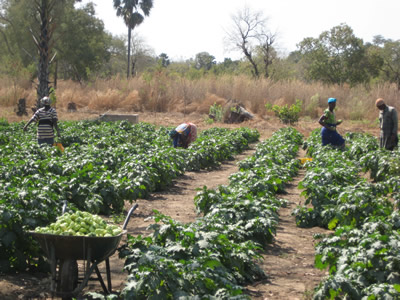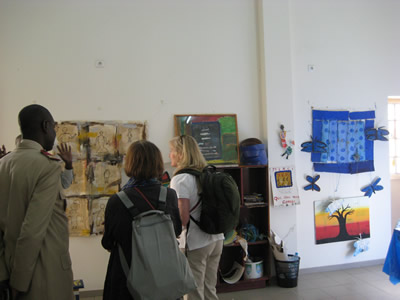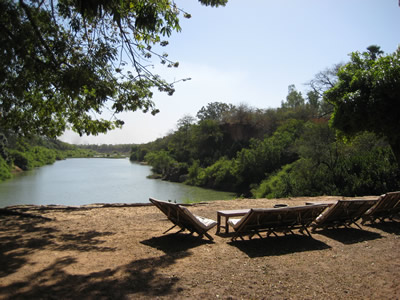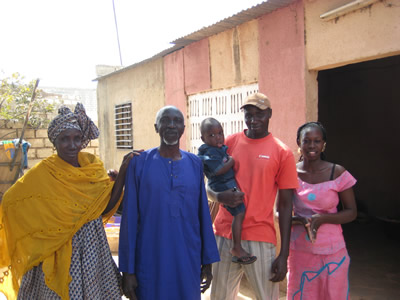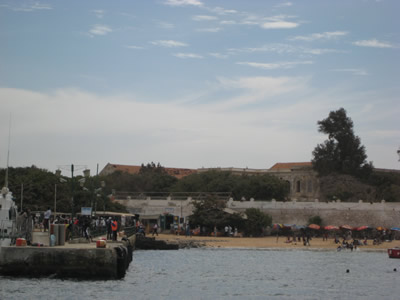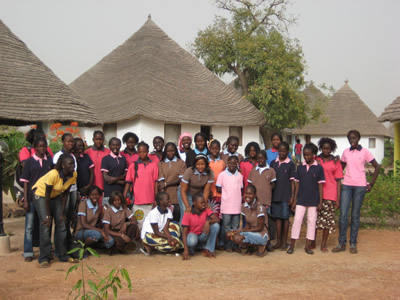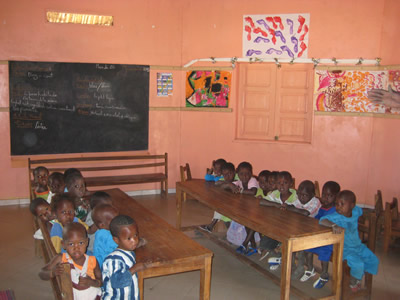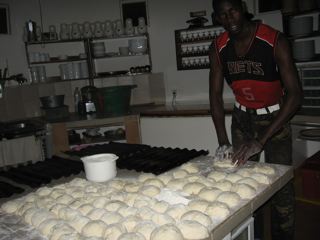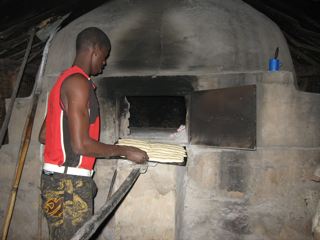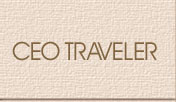 |
|
|
|
|
|
|
|
|
|
|
|
|
|
|
|
|
|
|
|
|
|
|
|
|
|
|
 |
 |
|
|
|
|
|
|
|
|
|
|
|
|

|
Senegal: Only connect
Fifteen years ago, a French dermatologist named Gilles Degois asked a friend of his, a nun, how he could make the world better. She told him to go to Senegal. Eight years ago, my brother, Nick—the cultural historian Nicholas Fox Weber, who was living in Paris while he wrote his biography of Le Corbusier—developed a rash in the crook of his elbow and picked Dr. Degois's name out of the Pages Jaunes. As Nick tells it, Gilles spent three minutes disposing of the rash, and then said, "Let's talk about what really matters, what I'm doing in Senegal. January 2010, and Nick and I were aboard a packed Air France flight from Paris to Dakar. We would spend a week in Senegal, visiting the medical centers, kindergartens, an agricultural co-op, and other wonders built and maintained in the Senegalese bush by Le Kinkeliba, the French NGO Gilles Degois founded. Senegal is francophone—it was French-controlled until fifty years ago, but most Senegalese also speak a dialect, principally Wolof. Kinkeliba is the Wolof name for a healing plant used in traditional medicine. As the name of a French NGO, it's emblematic of Gilles and his colleagues' philosophy—to save and change lives, yes, but in always acknowledging local values and working in partnership with the communities served. One early project, a medical co-op for banana growers, is now self-sustaining, and that's the goal for others. This was my brother's fourth such trip. After his first enthralling visit to Senegal, he started a not-for-profit back in Connecticut, American Friends of Le Kinkeliba (AFLK), under the aegis of the Josef and Anni Albers Foundation, which he directs. The Alberses, Bauhaus artists who fled Germany for America and at one point in their lives were nearly penniless, made the goal of their Foundation "the revelation and evocation of vision through art." They were also exceedingly pragmatic and, in Nick's words, "recognized that without certain necessities it's impossible to enjoy the miracle of seeing." Satisfying for me to fill a bag with crayons, markers, and bright plastic webbing for the new kindergarten, but they wouldn't do much good if Le Kinkeliba weren't also providing hygiene and vaccinations. Nick and I would get to Dakar around midnight and meet up tomorrow with four American women, whose flight was due at 3 a.m. I knew two of the women: Anne Barker, the indefatigable and often hilarious director of AFLK, and Sara Ohly, gracious and soft-spoken sociologist and the widow of the architect Nick Ohly, to whose memory a kindergarten in the village of Sinthian would be dedicated during our visit. Nick O., my brother's longtime friend and tennis partner, had visited some Kinkeliba sites shortly before his sudden death in November 2007, and was especially taken with the kindergarten in Niemenecke (like Sinthian, a village outlying the city of Tambacounda in way-eastern Senegal). The other members of our party were a relative-through-marriage of Sara's and a pal of my Nick's from the board of Outward Bound.
Nick and I were flying an older, smaller, less glam Air France craft than the one that brought me from New York to Paris. Nick is younger but taller, and I conceded him the aisle seat. As we gained altitude, I scrunched against the window, awaiting a two-Ativan anxiety attack. It never struck. The flight turned out to be the best of my life—a route Antoine de Saint-Exupery might have piloted and the bold abstractionist Soulages might have painted, the sky black on black with a flaring thin red line at the horizon, a sunset stain that lingered almost to midnight, lighting our way. Senegalese tourism boasts of its nearness to the States—Dakar, the westernmost point of Africa, is only seven and a half hours from Washington or New York; but I don't have to explain the pleasures of a three-day detour through Paris. And now we had the lagniappe of this six-hour vol de nuit, buoyant and true, tracing the edge of the continents. I would swear I felt the curve of the earth as we head south and west. It's the way to go if you can. The slight shabby interior, which had dismayed me when we boarded, seemed a plus by midflight—deeper values at play. My maiden trip to Africa, and a much-traveled friend had told me to ready my psyche for a blow when I landed at the Dakar airport. He was talking about the beggars, the moneychangers, the calling-card vendors and peanut-mongers, and as soon as we cleared customs, here they came, a brightly clad, fast-talking throng, jostling for our attention as we made our way to the baggage claim area. The neediness pierced my soul, as it must. The blow to my psyche came from something else. Crazy, but the crowd was good-natured and vital, almost ebullient! I didn't feel threatened or hustled—well, maybe a little hustled, like at a carnival, a street-fair. If I said, "No, merci," or explained that I didn't have CFAs (the local currency, Communaute Financiere Africaine francs, (pronounced Cee-FAs), I got a grin, I was off the hook, I was made to think I'd done enough by acknowledging our common humanity. It wasn't enough, of course, any more than it's enough to give someone a smile on the hungry streets of New York. Still, there was no gainsaying the covalence of need and jollity. What did it mean? Something I needed to grasp: that much was sure. I breathed in the warm, dusty air—foreign to my taste and oddly delicious. Suddenly my ponderings were derailed by a wild, deep, pulsing screech. Ogod, an emergency siren? Some jungle chorus—baboons howling at the moon or the famously loud Abyssinian hornbills in orgy? I'd never felt so assaulted by a noise, high-pitched and yet grating; a diabolical sound system must be magnifying the madness. And then Nick and I were at the conveyer belt, which was disgorging bits and pieces of baggage at a lugubrious pace, and I realized this I was hearing nothing more supernal than un-oiled metal scraping on metal as it lumbered and clunked along.
No point in conversation. Anyway, what needed to be said? Nick and I were born in white West Hartford and now we were in black Dakar. The night wrapped gently around us. Our bags would come or they wouldn't. My brother looked dreamily happy. Later he would tell me it's because the Dakar airport luggage carousel emits the only sound on earth that drowns out his tinnitus. Welcome to the paradox that is Senegal. A week is hardly enough to grasp the ineffable singular something defining a country and its people. A lifetime may not be enough. But the Senegalese something is a big, sweet fruit ripe for the picking, even in the chaos of the airport: happiness where you least expect to find it, happiness in defiance of reason. Happiness studies are the rage these days. Wikipedia, for instance, offers a micro-econometric equation of subjective/objective wellbeing. In issue after issue of The Journal of Happiness Studies, social scientists of all stripes grope to understand why lottery winners get the blues while the poor and sick may feel blessed. I used to think we travel to find new ways of being happy. Looking back at my trip to Senegal, I think we travel to lift the veil from an enduring mystery: the nature of happiness itself. It would be obscene to romanticize the woes of Senegal: beggar boys so thin you wonder where their innards are stored; highways that are dusty lacework of potholes; villages with no running water and hit-or-miss electrical power; teenage mothers destroyed by obstetrical fistula. Le Kinkeliba was started, and American Friends exists, because these terrible conditions touch every Senegalese life, and the government provides almost no social services. And yet I saw, and felt, an imperative to be happy that can't be argued away. Predictable, of course, that I would have a rich adventure. My trip wasn't voluntourism, I wasn't raising roofs; but the men and women doing the hard work on the ground in Senegal found our presence spirit-raising, and in turn our spirits were raised by their pleasure in our witness. Factor in as well that travel with my brother is a richly layered thing, echoing trips from our childhood, carrying our parents' values to a place they never saw but would have loved. And we spent the week in superb company—American, French, and Senegalese. We stayed in atmospheric hotels in Dakar and the bush (details follow). An unexpected bonus for me: the hot, dry air bought me an instant reprieve from arthritis, and my spine was reborn, 20 years younger. But beyond the particular pleasures of my experience: that defining something. In Sophie's Choice, Styron's protagonist excoriates people who suffer what he calls "unearned tragedy." Senegal is the mirror opposite, a nirvana where happiness is the default emotion, malaria and all. When I returned to Paris after a week, I had dinner with some of Nick's Kinkeliba cohorts, including a psychiatrist who has been deeply involved with its clinics from the start. I drank enough good wine to try to express my thoughts in French. "I'm a little embarrassed at how happy I felt in Senegal. I saw terrible things, but still I was happy…in great part because there seemed to be so much happiness around me. More than I see in Paris or New York, where we all lead beautiful lives. Or am I just imagining this Senegal?" He smiled kindly and said that I wasn't imagining it. And that he'd been considering this paradox since this first visit. Along with the friend who warned me to guard my psyche in the airport, other friends sent me off with stern injunctions as to my body parts. I must wear sunscreen and mosquito repellent, awake or asleep, and absolutely no perfume. A broad-brimmed hat, long sleeves, and never sandals, no matter how thick the heat. Only bottled water and not just any bottled water; stick with bubbles, harder to fake with stuff from the tap. "Shake out your bedding at night and your shoes in the morning—scorpions love to hide there." I might well die in a traffic accident; I must be careful where I went in what vehicle with whom at the wheel. "For god's sake don't eat the salads, not even at the hotel." No one warned me about the happiness—perhaps the most severe risk for the Western traveler. I love the man and the Greenwich Village life I came home to, yet six months later I'm in a lather, a near-panicky swoon when I think of Senegal. I left some part of my heart in Wassadou, on the banks of the green Gambia River, where baboons sing before first light. (They do sound a bit like the luggage carousel.) I dream the Paul Klee desert pastels of that gorgeous wreck of a city Kaolack, whose buildings seem to slant and tilt—possibly there are no right angles in Kaolack. I'm near desperate with the need to persuade my children and friends and good strangers that Senegal needs them and they need Senegal. Many happiness experts believe that the single most determinative factor in the quality of a life is connection. So, noodling the Internet this morning, trying to gain insight into my delirium, I came across numbers that pulled it all together for me. As of two years ago, one person in three in Senegal owned a mobile phone; data collected last month suggest that eighty-five percent of Senegalese have Internet access, making it the most wired African country. In this world, we're wired to the nth, but mostly we connect to data; intimacy is, if anything, diminished or superficial. Over there, it's a different matter. The Senegalese are obsessive about staying in touch—literally. It's the land of the handshake. Walk into a kindergarten classroom, and twenty children will shake your hand and shake it again when you leave. And maybe shake it again if they see you in a different building. Our drivers and guides, Saliou Seck and Pape (pronounced Pop) N'Draye, shook hands with each other and their new American friends each time we met anew—say for a meal—even if we'd been apart just long enough to freshen up. Everyone's handshake had its nuances, its own style and special message. On our way from Dakar to the bush, we stopped at Saliou's village to meet his family, and his wife had a handshake I will never forget (or stop craving to feel again): a kind of slap, and a slide, and a clasp, positively electric, somehow solemn and funny at once, a wordless conversation that continues in my head.
We also stopped to tour a small municipal hospital whose director hoped to get support from LeKinkeliba. We saw a twelve-year-old girl lying still as death (acute appendicitis) on a hard bench while her parents were out searching for two hundred dollars to buy anesthesia. That's the harrowing part of the story. The beautiful part is that the doctor showing us around had come from Dakar twelve years ago to do a six-month stint—and had never left this desperate outpost. He assured us that the girl would have her surgery at midnight, with or without her parents' contribution, even if he had to reach into his own pocket. He refused to let us reach into ours. (We called from the road to ask after her; she was recuperating nicely. And Le Kinkeliba has since arranged to help fund the hospital, with special emphasis on children in need.) I know many brilliant and caring doctors in New York, but for better and worse they have their boundaries. In Senegal, it's different. Leopold Sedar Senghor, the poet who was the country's first president, insisted that the Senegalese were a single people; he made a surgical strike against tribal warfare with his emphasis on what he called negritude. While the word sounds limiting and exclusionary to modern ears, and has fallen out of philosophical fashion, Senghor wanted to open doors, not close them. Educated in Paris, and the only African ever elected to the Academie Francaise, he envisioned a self-assured nation engaging with the west as equals. Historians, economists, and sociologists surely offer learned explanations of why Senegal is Senegal. I'm guessing that Senghor, more than any other person or factor, created the something that struck me so forcibly. We are all in it together. Whatever our differences, our commonalities count for more. Negritude in 2010 isn't what we now call attitude; my skin seemed to count for less than in any other place I've visited, including parts of my own city. Thus the endless handshaking. The doctor for whom each patient is treated like family. The widespread use of the intimate tu form of French, ever so different from the vous of Paris, even among longtime acquaintances. "Tu as bien dormis?" inquires your waiter at breakfast in Dakar, no matter that you've never met before, that he's staff and you're guest, that on a census form you would add up as polar opposites. One more story. On our way back from the bush to Dakar, we stopped in the city of Thies to visit a school that Le Kinkeliba helps support: Saint Anne's Convent School, run by the sisters of Saint Joseph of Cluny. We toured classrooms where Christian and Muslim students are educated side by side. We ate superb chicken yassa (grilled birds with a lemon onion sauce) and oranges grown on the grounds. "We'll see you soon," one of the sisters said warmly, as we exchanged goodbyes. And then she, a Catholic nun, added the phrase that devout Muslims append to any mention of future events. "Insha'Allah." God willing. One country, one God, one world. The sisters need more computers, please; they will be used to plug in, not tune out. In college, our generation all read Howard's End, and we knew that that E.M. Forster was telling us what we very most needed to know: "Only connect!" And off we went to invent our lives, quickly forgetting what connection means. It's not about networking our way to power and success. It's about wholeness. "Only connect the prose and the passion, and both will be exalted, and human love will be seen at its height. Live in fragments no longer." Lucky the midlife traveler who goes to Senegal and learns anew what matters. And while you're there, don't miss: Dakar
The afternoon red sun, juicy as a blood orange, seen from the smooth-pebbled beach below the Hotel Savana. It's not the most luxurious hotel in Dakar but it's probably the best situated, with a seaside resort feeling that's heaven for someone escaping the American winter, the high season for Senegal tourism. Do try to score a room with a balcony (and take care not to lock yourself out onto said balcony). A chicken sandwich at midnight—avocado, great baguette—is a perfect meal upon arrival from Paris. Exotic cocktails. (http://www.savana.sn) Ile de Goree, the launch point for much of the slave trade, with its hauntingly beautiful pastel Maison des Esclaves. You will marvel that horror and beauty co-exist this way. Some debunkers think the house of slaves is a tourist myth—physically illogical as a launch point; but the historical truths carry the day. (http://www.mairiedegoree.org) Dubuffet-like watercolor faces, scrap-metal sculptures, and more savage beauty at Dakartherapie, , a permanent revolving exhibition created under the aegis of therapists and local professional artists at the impressive Hôpital Principal (http://www.hoptalprincipal.sn). Thanks to Katharina Lobeck Kane's excellent Lonely Planet guidebook, The Gambia & Senegal, for the tip. The indoor/outdoor fabric market: Senegalese women are known for their dazzling boubous, kaftans with matching turbans, and the market is a timeless souk, a riot of oranges, turquoise, and red-black-yellow patterns. In perfect contrast, the ultra-modern supermarkets, which cater mostly to wealthy foreigners, offer a good place to stock up on pristine packages of pre-cooked grains (legal to bring home) such as fonio, the sesame-size form of millet, light and fluffy. Cabane des Pecheurs on the Plage de N'Gor, perhaps for a perfect last supper on your way to the airport (no website but many online references). As you eat superbly simple dishes built around the local catch, you'll watch moonlight play on the water, all so very Bogey and Bacall, and you won't want to leave. Kaolack You may read online that Kaolack is three hours from Dakar. Don't believe it. One minute the road is new blacktop, and just as you pick up a breeze, the road turns into a path, with so little navigable surface that traffic from east and west are sharing the same strait. No matter how promptly you leave Dakar in the morning, you will be very ready for lunch when you get to the strange, dreamy precincts of Kaolack, a trading crossroads. The Hotel de Paris will feel like a refuge invented just for you by Somerset Maugham. You will order chicken yassa, and the birds will be brilliantly blistered. If your digestion is behaving, order the fried potatoes; otherwise, the rice. Either way, you'll agree: one of the ten great lunches of your life. (http://www.hoteldeparissenegal.com) Wassadou
It's a long day's drive from Dakar east across the country to paradise called Wassadou. (You may fly to the nearish city of Tambacounda, of course missing lunch in Kaolack.) But long by what measure? It's a commonplace that for westerners time moves more slowly in Africa. Perhaps it's because there are very few road signs. An endless succession of villages look much like one another to foreign eyes. This manic New Yorker quickly caught on that surrender was the only option. Wassadou would be there when we reached it. Our party traveled to Wassadou because many of Le Kinkeliba's projects are in that region. We visited two shiningly happy kindergartens, two pristine medical clinics, a verdant agricultural co-op boasting the largest pump in Senegal (thanks to the fanatical dedication of several families of French engineers and industrialists), and the Foyer des Jeunes Filles, a safe and gorgeous home-away-from-home without which there would be no education for high-school-age girls from remote villages. For more detail and beautiful images, please visit these and other Kinkeliba projects online through the American Friends website (http://www.lekinkelibaus.org).
Eventually, I hope, there will be a way for more visitors to see the projects live and meet the Senegalese who deliver their vital services. Meanwhile, Wassadou is a famous draw for the wildlife in the Nikolo-Koba national park. And, even without other purpose in the neighborhood, it's worth the trek to spend a few nights at the Hotel Campement de Wassadou. (http://www.niokolo.com) Guests sleep in the typical thatched roof huts of the region. The water in your shower is cold, and electric lights are on only for the early morning and late evening hours. But you have a private western-style toilet, which by the time you get out of your car feels like grand luxe. Altogether, it's one of those rustic hideaways that offers gracious service and a deep level of comfort. The bar has Gazelle beer; bring your own gin or vodka, and the crew will set you up with tonic and the salted roasted peanuts that define the cocktail hour in Senegal. You might drink in the lounge area or in one of the wooden chairs by the Gambia river—its placid green surface offering pleasure enough even if no hippos show up. Dinner is a set meal, usually a salad starter and a couscous or stew. Oh, but breakfast! The simplest food in the world: bread, butter, and honey. But Senegalese honey has the palette of a sauvignon blanc, with overtones of passion fruit and pear. And then there's the bread. It has a crust that snaps and crackles, with an interior that yields just enough.
I'm invited to watch a young baker, Alou, make the bread. At midnight, while the camp sleeps, I cross quietly to the kitchen, where he stirs the dough—flour, salt, instant yeast, and water. He pulls out a handful and weighs it in his palm, pinching off a bit or adding a bit as needed; flings the mass down, shapes it into a ball and kneads it, then shapes it into a baguette and puts it in a slotted bread pan. Repeat 47 times. He carefully lays his immaculate apron over the loaves, and then lets them rise for 40 minutes (while I sleep dreamily, after extracting a promise that he'll knock on my door when it's time for the baking). The moon is so high in the sky I must be forgiven for foolishly wondering how it got there. Alou carries the pans to the hut where a wood fire has burned down to coals in a deep stone oven. He paints the bread with honeyed water, lets the dough rise another half hour on the hearth. Then the pans are fired for 20 minutes on one side and five or six on the other. Alou gives me the fragrant first loaf. I give him the last of my Paris dark chocolate, except for one square that I sandwich into a bite of hot bread. Man and woman cannot live by apples alone. If ever there was an Eden, surely it was here, in Senegal, and bread graced the breakfast table. -- Nancy Weber, 2010 Summer 2010 |
||||||||||||||||||
